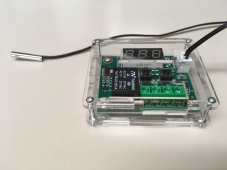McKravitts
Solar Enthusiast
- Joined
- Sep 8, 2022
- Messages
- 536
I'm new to solar, but I have some electronics background.
I found several references and utube videos online regarding the lack of freeze protection installed on LIFEPO4 batteries.
It is often considered an important factor in grading battery quality.
Most systems do however have high temperature protection.
There is a simple way to make the high temp protection also do freeze protection without sacrificing the high temp protection.
Most if not all temp sensor used in HVAC, batteries, appliances and solar devices, are NTCs (Negative Temperature Coefficient) resistors.
The quickest way to explain how the hack works is by example.
Assume your system (Battery, Charge controller, inverter charger etc.) uses a 10 k nominal ohm NTC. The 10 K is the value of resistance at 25 C (77 F).
This is just an example and the method described here will work with any NTC with any nominal resistance.
Assume you device shuts down at a temperature of 135 degrees F (about 55 C). At 55 C the resistance of the 10 K NTC will be about 3.5 kohms.
At 0 C (32 F) the resistance will be about 27 kohms.
Paralleling a 4 kohm resistor with the temp sensor would reduce the total resistance at 32 F to around 3.5 K and the unit should shut down from what it perceives as high temp cut off.
There are many ways of doing this and one can get as creative as one likes.
One of the simplest is a cheap over the counter freeze protect snap disc thermostat in series with a 4 kohm resistor, This series combination is then paralleled with the existing temp sensor.
When the temperature is above freezing the snap disc is open and the hack has no effect on the performance. In freezing temperatures the thermostat snap (disc) closes and the resistance suddenly drops, triggering the high temp shut off circuit. If the temperature rises the thermostat opens and the unit functions as normal.
I found several references and utube videos online regarding the lack of freeze protection installed on LIFEPO4 batteries.
It is often considered an important factor in grading battery quality.
Most systems do however have high temperature protection.
There is a simple way to make the high temp protection also do freeze protection without sacrificing the high temp protection.
Most if not all temp sensor used in HVAC, batteries, appliances and solar devices, are NTCs (Negative Temperature Coefficient) resistors.
The quickest way to explain how the hack works is by example.
Assume your system (Battery, Charge controller, inverter charger etc.) uses a 10 k nominal ohm NTC. The 10 K is the value of resistance at 25 C (77 F).
This is just an example and the method described here will work with any NTC with any nominal resistance.
Assume you device shuts down at a temperature of 135 degrees F (about 55 C). At 55 C the resistance of the 10 K NTC will be about 3.5 kohms.
At 0 C (32 F) the resistance will be about 27 kohms.
Paralleling a 4 kohm resistor with the temp sensor would reduce the total resistance at 32 F to around 3.5 K and the unit should shut down from what it perceives as high temp cut off.
There are many ways of doing this and one can get as creative as one likes.
One of the simplest is a cheap over the counter freeze protect snap disc thermostat in series with a 4 kohm resistor, This series combination is then paralleled with the existing temp sensor.
When the temperature is above freezing the snap disc is open and the hack has no effect on the performance. In freezing temperatures the thermostat snap (disc) closes and the resistance suddenly drops, triggering the high temp shut off circuit. If the temperature rises the thermostat opens and the unit functions as normal.




